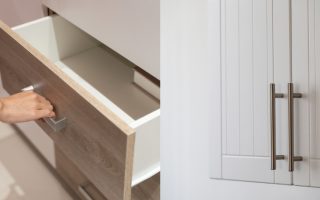Your kitchen cabinets are a major focal point in one of the busiest rooms in the house. Over time, they can accumulate grease, grime, and dust, making them look dull and less attractive. Revitalizing your wood cabinets with a thorough cleaning and a touch of shine will restore their beauty and enhance your overall kitchen space. In this comprehensive guide, we’ll share the best techniques and products to get your cabinets gleaming.
Understanding Your Wood Cabinets
Before jumping into cleaning, let’s take a moment to consider the type of wood and finish you have.
- Solid wood or wood veneer: Knowing if the wood is solid or veneer influences how much moisture you can safely use during cleaning.
- Finish: Your cabinets are likely protected by a finish like varnish, polyurethane, lacquer, or paint. This impacts which cleaning products are safe to use. If in doubt, start with the gentlest methods and move to stronger ones only if needed.
Gather Your Supplies
Here’s what you’ll need to clean and shine your cabinets:
- Mild Dish Soap: Your go-to cleaner for regular maintenance.
- White Vinegar: A natural degreaser and cleaner.
- Baking Soda: Excellent for tackling tough grease stains.
- Microfiber Cloths: Soft and gentle on your cabinets.
- Soft-Bristled Brush (optional): For nooks and crannies.
- Furniture Polish or Wax (optional): Provides extra shine and protection.
- Commercial Wood Cleaner (optional): For very stubborn grime.
Step-by-Step Cleaning Process
Step #1: Dusting
Use a dry microfiber cloth or a feather duster to remove any loose dust and debris. Start from the top and work your way down, so you don’t end up re-dusting areas you’ve already cleaned.
Step #2: Mix your Cleaning Solution:
- For regular cleaning, combine warm water with a few drops of mild dish soap. This will tackle most everyday dust and light grime.
- For a touch of extra cleaning power and a fresh scent, make a 50/50 mixture of warm water and white vinegar. Vinegar is a natural disinfectant and cuts through grease.
Step #3: Work in Sections:
Start with a cabinet’s inside, then move to the doors. This prevents dripping on already-cleaned areas. Focus on one manageable section at a time for thorough cleaning.
Step #4: Wipe Down:
Dip your microfiber cloth in the cleaning solution, wring it out well (it should be damp, not soaking), and gently wipe down surfaces. For textured areas, use a soft-bristled brush to get into the nooks and crannies.
Step #5: Tackle Grease:
For stubborn grease, mix baking soda and a little water to form a paste. Apply to the stain, let sit for a few minutes, then gently scrub with a damp cloth. The baking soda will break down the grease, making it easier to remove.
Step #6: Rinse and Dry:
Wipe the cleaning solution away with a clean cloth dampened with plain water. Immediately dry the surface with a dry microfiber cloth. Drying prevents water spots and streaks.
Additional Tips:
- For heavily soiled areas, let the cleaning solution sit for a few minutes before wiping it away. This gives it more time to work.
- Always test your cleaning solution in a small, hidden spot before using it on the entire surface.
- Wear gloves to protect your hands from harsh cleaning chemicals, if desired.
Deep Cleaning: Going the Extra Mile
For heavily soiled or neglected cabinets, stronger methods are sometimes needed:
- Commercial Wood Cleaner: Follow the product’s instructions carefully and use in a well-ventilated area.
- Remove Cabinet Doors and Hardware: This allows for more thorough cleaning and access to hinges and hardware.
How to Shine Kitchen Cabinets
Once your cabinets are beautifully clean, consider these options for that extra sparkle:
Natural Polish
Mix equal parts olive oil and distilled white vinegar in a spray bottle or small bowl. The oil provides shine and light conditioning, while the vinegar cuts through residual grease and adds a light sparkle. Apply the mixture with a soft, clean cloth, let it sit briefly on the wood, and then buff to a shine with a dry microfiber cloth.
Furniture Polish
Choose a polish designed specifically for your type of wood cabinets. Apply the polish sparingly according to the manufacturer’s instructions. Typically, you’ll spray or dab a small amount onto a microfiber cloth, then wipe it across the cabinet surface in gentle, circular motions. Buff any excess with a separate dry microfiber cloth.
Furniture Wax
Wax provides a harder, more durable shine than polish and can enhance the protection of your cabinets. Apply a thin layer of wax following the product instructions, allow it to dry, then buff it to a beautiful shine with a clean, soft cloth. Keep in mind that furniture wax may require a bit more elbow grease to apply but provides a longer-lasting, protective sheen.
Important Tips
Taking a few extra precautions will keep your kitchen cabinets looking pristine and protect them for years to come.
Test First
Before using any cleaning solution or polish, always test it in an inconspicuous area first. This is especially important for older cabinets or those with sensitive finishes. A small test spot will ensure the product won’t damage the overall look of your cabinets.
Avoid Harsh Cleaners
Ammonia, bleach, abrasive scrubbers, and other harsh chemicals can potentially strip the paint, stain, or damage the finish of your cabinets. Stick to gentle cleaning solutions and avoid anything that could scratch the surface.
Dry Thoroughly
Lingering moisture can cause water spots and, in extreme cases, warp your cabinet doors. Use a soft, dry microfiber cloth to immediately dry all surfaces after cleaning or rinsing.
Handle Hardware Carefully
Don’t forget about your cabinet pulls, knobs, and hinges! Clean them according to their material with an appropriate solution. For very stubborn grime, consider removing hardware for a thorough cleaning and then reinstalling them.
Don’t Forget the Interiors
Cleaning the insides of your cabinets is just as important as the exterior. Regularly wipe down shelves and drawers using your chosen cleaning solution to remove crumbs, spills, or dust.
Additional Considerations
- Scratches and Dents: Touch up scratches with a wood stain pen or furniture marker. Consult a professional for deeper scratches or dents.
- Water Stains: For light watermarks, try buffing with mayonnaise, petroleum jelly, or a dab of non-gel toothpaste on a soft cloth until the mark disappears.
- Sunlight Protection: Minimize cabinet exposure to direct sunlight to prevent fading.
Maintenance is Key
A little regular maintenance goes a long way in keeping your wood cabinets looking beautiful. Proactive care prevents buildup and makes deep cleaning sessions much less frequent.
Wipe Up Spills Immediately
Don’t let grease, food spills, or liquids sit on the wood for extended periods. Acidic substances like tomato sauce or citrus can etch into finishes, and grease creates a stubborn film that attracts more dirt. Wipe up spills quickly to prevent potential staining and damage.
Regular Dusting
Dust may seem harmless, but over time the particles can act as a mild abrasive and create a buildup that’s harder to remove. A quick weekly dusting with a dry microfiber cloth or duster will help keep your cabinets looking clean and prevent long-term grime accumulation.
Avoid Excess Moisture
Wood cabinets and excess moisture don’t get along. Always use a damp (not soaking wet) cloth for cleaning and immediately wipe away any residual moisture afterward. Avoid spraying water or cleaning solutions directly onto the surfaces.
Handle with Care
Prevent dings, scratches, and chips by being mindful of how you use your cabinets. Avoid slamming doors, bumping them with pots and pans, or placing heavy objects with sharp edges directly against the wood.
Frequently Asked Questions (FAQs)
1. Can I use a steam cleaner on my wood cabinets?
While steam can provide effective cleaning, it’s usually best to avoid using it on wood cabinets. The extreme heat and excess moisture can potentially damage finishes or warp the wood.
2. How often should I clean my kitchen cabinets?
Ideally, a quick wipe-down with a damp microfiber cloth after heavy cooking sessions is best. At a minimum, do a thorough cleaning every few months, depending on use.
3. My cabinets have a strong odor. What can I do?
Placing an open box of baking soda inside cabinets can help absorb odors. Regularly cleaning and ensuring the interiors are fully dry also helps.
4. Are there any natural alternatives for shining my cabinets?
Lemon oil is a natural choice, but use it sparingly (diluted) and test in an inconspicuous area first, as it can affect some finishes.
5. When should I consider professional cabinet refinishing?
If the finish on your cabinets is severely damaged, significantly discolored, or you simply want a new look, professional refinishing or repainting might be a good option.
Conclusion
Cleaning and shining your wood cabinets might take some time and effort, but the results truly revitalize your kitchen. By following these techniques and establishing a regular cleaning routine, you’ll enjoy beautiful, long-lasting cabinets that bring warmth and charm to the heart of your home.




